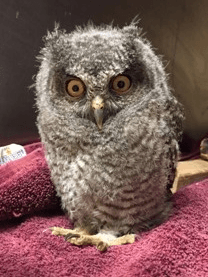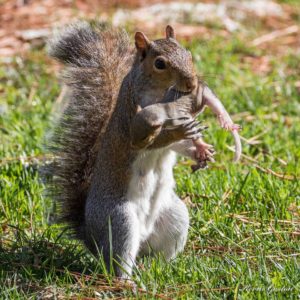What to Do if You Find a Baby Animal Part 2
Baby Birds and Baby Squirrels
Written by Wildlife Director, Kathryn Dudeck
Spring brings buds, blooms, rains, and lots of calls to the Wildlife Department at CNC about baby animals. While we are licensed and trained only for raptors, reptiles, and amphibians, we respond to over 150 requests each month in spring regarding wildlife babies. Here’s what you can do to help the little ones you may encounter:
Baby Birds:

The first question we ask is “Is it naked, covered in fluff, or have fluff, feathers, and a stumpy tail?” It depends on the answer as to what needs to be done, if anything. If the baby is naked or covered in fluff, it should not yet be out of the nest. If possible, place the baby back into the original nest, ensuring to look on the ground, in low shrubs, and tree branches, since some species only nest 3-4’ off the ground and others actually nest on the ground. If you cannot find the nest, place dried grass and leaf litter in a small basket and place it/hang it in the closest tree. The parents cannot pick the baby up, but they will tend to it in the surrogate nest.
If the bird is partially feathered and has a stumpy tail, it is a fledgling and is supposed to be on the ground. This is the critical time it is building flight muscles and learning from its parents what to eat and how to hide. If the bird has wandered into a roadway, gently pick it up and place it under some nearby bushes. It will start calling once you leave and the parents will relocate it. It is an old wives’ tale about human scent. This myth started when people tried to put fledglings back in the nest and they jumped out or were pushed out by the parents so that they could continue teaching them.
Baby Squirrels:

By far, our most frequent phone calls this time of year are regarding baby squirrels. Eastern gray squirrels have two peak breeding seasons in the south, and we are right in the middle of the first one. Mother squirrels can have 8-9 babies each litter, and place 2-3 babies in each nest they have already constructed. Mothers visit the nests in the same order multiple times each day to care for the young. If one of the nests is falling apart, getting cramped, etc., she carries the babies in her mouth one at a time down the tree and leaves them on the ground. She will then carry them, again one at a time, up to one of the other nests. If you encounter a baby squirrel on the ground (the only rodent in GA with black toenails), gently place it in a box with some grass clippings and leaves and leave the box on the ground. If neighborhood cats are a concern, you can wedge the box in a nearby tree or shrub. Give the mother 4 hours to retrieve the baby. If she has not returned by then, call a licensed small mammal rehabber. Please note that she will not retrieve the baby at night.
Take a look at Part 1 – baby rabbits and turtles – here!
The Mission of the Chattahoochee Nature Center is to connect people with nature. Learn more at www.chattnaturecenter.org.
